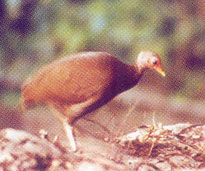The Great Nicobar Island is the southern most island of Andaman & Nicobar archipelago and also the southernmost part of India. Geographic isolation of these islands has resulted in high degree of endemism.
 Nicobar megapode, a threatened species, is endemic to this island.
Nicobar megapode, a threatened species, is endemic to this island.
The Nicobar megapode is heavy bodied bird of the forest floor. Most of the megapodes are brown, blackish or grey in colour. Bare skin on the face and neck may be coloured yellow, blue or dull red. Though
they can fly, primary movement is by walking. They build incubation mounds in sandy areas on the coastal forest. The megapodes do not hatch their eggs by sitting on them. The parents defend the mound while eggs are incubating inside. Monitor lizards and humans
are the greatest threat to these eggs. IUCN lists Nicobar megapode as a vulnerable species. Wildlife Institute of India and the Salim Ali Centre for Ornithology and Natural History have been studying this species in detail.
Wildlife management in the islands aims at protecting and conserving the biodiversity and their representative ecosystems. Protected areas cover about 30 percent of the Nicobar Islands, and only 14 percent
of the ecoregion’s native forest has been lost.
Proposals to make the Nicobars a major tourist destination pose a major potential threat in the future, along with road development and the rubber and cashew trade.
( Photograph of Nicobar megapodes by Dr. K. Sivakumar, Wildlife Institute of India, Dehradun)